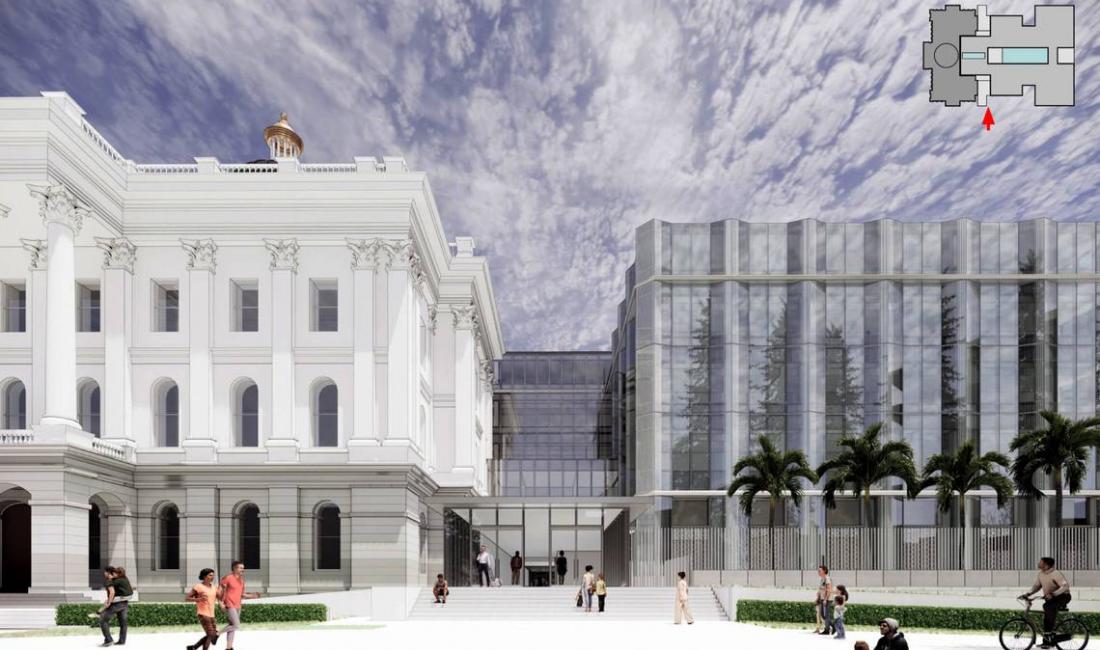An office building for state will take local parkland and cost $1.2 billion
Proposed new annex, from state records, Joint Rules Committee. This was originally produced by Zócalo Public Square.
At the very center of state government, you’ll find a hole in the ground demonstrating that the people who make California laws can’t live by them.
That hole is, for now, the Capitol Annex Project. The project is supposed to replace a 72-year-old office wing of the Capitol building—the “annex” where the governor and legislators kept their offices—with a 21st-century building. The new annex, like its now torn-down 1952 predecessor, would connect to the 19th-century main Capitol building.
Like much of California, the previous annex needed renovation—plumbing, sprinklers for fires, Décor was drab. Rooms were cramped. Governors complained about the lack of space for ceremonies and big staff meetings (Arnold Schwarzenegger complained the bathrooms were so small he couldn’t pull down his pants in them). Lawmakers wanted additional space for hearing rooms and to allow policy committees and their staffs could be inside the Capitol complex.
A renovation, with expansion, might have met those needs. But in 2018, the state legislature and Gov. Jerry Brown decided to tempt fate, by tearing down the annex and building an expensive new building for itself.
Six years later, the old annex is gone, but nothing has risen in its place. And there is as yet no completion date for the new building.
If you ask people in and around the Capitol why they can’t build themselves a new home, and you’ll hear much speculation. It was the pandemic. It was all the extra time it took to tear down the annex with great care, so as not to damage the historic Capitol building.
But no one really knows because of unusual secrecy surrounding the project. The project website has gone years without updates. State employees involved in the Capitol Annex can’t talk because they were required to sign a confidentiality statement, called Amendment D. The project’s leaders have excluded the Historic State Capitol Commission, which is supposed to oversee the annex and Capitol Park, from planning. Environmentalists, who object to the removal of trees from Capitol Park to accommodate the annex, are also frozen out.
As a result of secrecy and delays, no one really knows what it will cost. The initial price was supposed to be $445 million. By 2019, that number had increased to $755 million. More recent estimates, gleaned from sources outside the project, put it at over $1.2 billion.
No single entity or person is really in charge. A project MOU that I obtained puts the state Department of General Service in charge of some facets of the project, and the legislature’s Joint Rules Committee in charge of others, with the two different entities sharing decision-making on still other facets. The project also has leaned on a Utah consultant to State Capitol projects.
But if you ask people at the Capitol who is really running things, most will tell you that the project’s greatest champion, former Assemblymember Ken Cooley is the real decision-maker, even though he left office two years ago. (Cooley told me that he believes strongly in the project—“I believe it will serve the public very well, and It will serve public policy very well”—but that he is not running it).
The publicly available details of the annex project do not inspire confidence. The design is ahistorical, making it incompatible with the classical Capitol building. It also could be dangerous. The all-glass façade “offers no protection from gunfire and allows terrorists to see where the CHP is taking the public or the Legislators,” wrote Dick Cowan, a former chair of the Historic State Capitol Commission, who resigned that post in 2020 to protest the annex project.
But what’s most galling about the project is the way that state government has sought to exempt itself and the project from the rules that govern building in California.
In 2022, as opponents were making progress in a court challenge to the annex project for violating historic preservation laws, the legislature slipped a last-minute trailer bill into the budget to exempt the project from having to consult the state’s historic preservation officer. The judge hearing the legal challenges to the annex declared that this legislative maneuver “gutted” the case “like a fish.”
This year, the legislature acted again after an appeals court found that the annex project violated CEQA, the California Environmental Quality Act.
Interest groups have long abused CEQA to block housing, renewable energy, and other construction in the state. But for decades, the legislature has defended the law, and mostly opposed efforts to reform it. When it came to their own annex, however, state lawmakers brazenly bent the rules.
Their tool was, again, a budget trailer bill that specifically exempted the annex from CEQA’s provisions, and from public scrutiny and judicial review. Gov. Newsom signed the bill, which included $700 million in funding for the project, earlier this summer.
Save Our Capitol!, an unincorporated group opposing the project (and funded by a local preservation who has remained anonymous), declared: “Politicians are not above the law, and they should not be permitted to simply undo environmental protections that inconvenience their pet projects.”
Despite the exemptions, construction so far has been limited. In recent weeks, there does seem to have been some concrete foundation work. Privately, state officials tell me the annex will eventually be built.
I wonder if retreat might be the wiser option. In tough budget times, many other state infrastructure programs could make better use of the $1 billion-plus dedicated to anew annex. And the Capitol does not require an annex. Lawmakers have been working in nearby office space since 2021. They can stay there, or find other offices among the empty commercial buildings of the Sacramento area. One project supporter suggests reducing the budget back to the original $445 million, and pursuing a more modest building at that price.
Whatever the fate of the annex, state officials should at least show that they’ve learned a lesson from their own faltering project—and give everyday Californians relief from the very laws and regulations that state government itself can’t abide.




